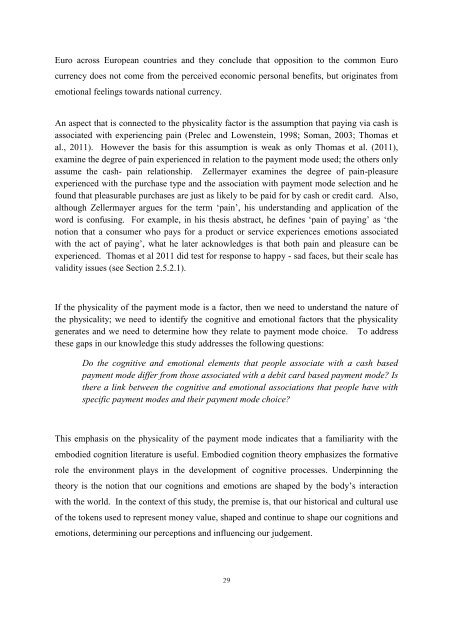Cash or Card: Consumer Perceptions of Payment Modes - Scholarly ...
Cash or Card: Consumer Perceptions of Payment Modes - Scholarly ...
Cash or Card: Consumer Perceptions of Payment Modes - Scholarly ...
You also want an ePaper? Increase the reach of your titles
YUMPU automatically turns print PDFs into web optimized ePapers that Google loves.
Euro across European countries and they conclude that opposition to the common Euro<br />
currency does not come from the perceived economic personal benefits, but <strong>or</strong>iginates from<br />
emotional feelings towards national currency.<br />
An aspect that is connected to the physicality fact<strong>or</strong> is the assumption that paying via cash is<br />
associated with experiencing pain (Prelec and Lowenstein, 1998; Soman, 2003; Thomas et<br />
al., 2011). However the basis f<strong>or</strong> this assumption is weak as only Thomas et al. (2011),<br />
examine the degree <strong>of</strong> pain experienced in relation to the payment mode used; the others only<br />
assume the cash- pain relationship. Zellermayer examines the degree <strong>of</strong> pain-pleasure<br />
experienced with the purchase type and the association with payment mode selection and he<br />
found that pleasurable purchases are just as likely to be paid f<strong>or</strong> by cash <strong>or</strong> credit card. Also,<br />
although Zellermayer argues f<strong>or</strong> the term ‘pain’, his understanding and application <strong>of</strong> the<br />
w<strong>or</strong>d is confusing. F<strong>or</strong> example, in his thesis abstract, he defines ‘pain <strong>of</strong> paying’ as ‘the<br />
notion that a consumer who pays f<strong>or</strong> a product <strong>or</strong> service experiences emotions associated<br />
with the act <strong>of</strong> paying’, what he later acknowledges is that both pain and pleasure can be<br />
experienced. Thomas et al 2011 did test f<strong>or</strong> response to happy - sad faces, but their scale has<br />
validity issues (see Section 2.5.2.1).<br />
If the physicality <strong>of</strong> the payment mode is a fact<strong>or</strong>, then we need to understand the nature <strong>of</strong><br />
the physicality; we need to identify the cognitive and emotional fact<strong>or</strong>s that the physicality<br />
generates and we need to determine how they relate to payment mode choice. To address<br />
these gaps in our knowledge this study addresses the following questions:<br />
Do the cognitive and emotional elements that people associate with a cash based<br />
payment mode differ from those associated with a debit card based payment mode? Is<br />
there a link between the cognitive and emotional associations that people have with<br />
specific payment modes and their payment mode choice?<br />
This emphasis on the physicality <strong>of</strong> the payment mode indicates that a familiarity with the<br />
embodied cognition literature is useful. Embodied cognition the<strong>or</strong>y emphasizes the f<strong>or</strong>mative<br />
role the environment plays in the development <strong>of</strong> cognitive processes. Underpinning the<br />
the<strong>or</strong>y is the notion that our cognitions and emotions are shaped by the body’s interaction<br />
with the w<strong>or</strong>ld. In the context <strong>of</strong> this study, the premise is, that our hist<strong>or</strong>ical and cultural use<br />
<strong>of</strong> the tokens used to represent money value, shaped and continue to shape our cognitions and<br />
emotions, determining our perceptions and influencing our judgement.<br />
29

















